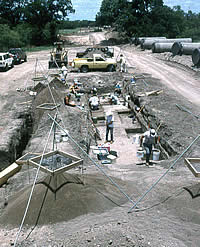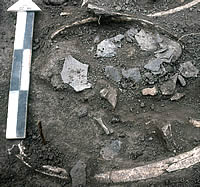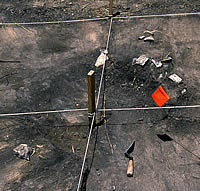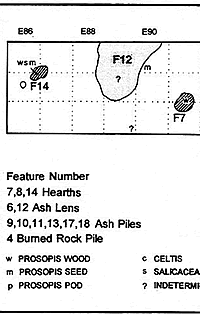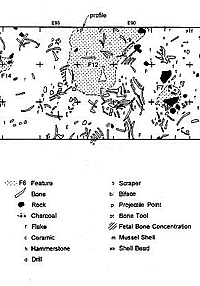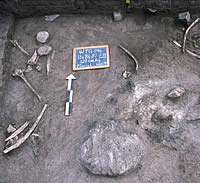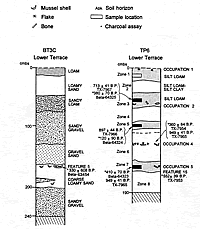Rush Site
The Rush site (41TG346) in western Tom Green County was the scene of a very successful communal bison hunt by a large group of Toyah hunters in the late 16th century. Here at least 100 people—probably representing several bands—killed, butchered, and processed an estimated 50 buffalo over a several week period in fall at this locality on the floodplain of the North Concho River about 10 miles northwest of San Angelo. The archeological evidence of this event was extraordinarily well preserved and thoughtfully investigated yielding many insights into the lives of Toyah peoples during the waning decades of prehistoric life.
The Rush site was investigated in 1993 by an archeological consulting firm, Mariah Associates, Inc., in advance of the construction of a large water pipeline. Although archeological excavations were confined to a narrow strip (the pipeline route) across the site, the researchers led by J. Michael Quigg made the most of the opportunity. Excavations encountered a thin occupation layer, estimated to date to about A.D. 1575, that had been gently buried by layers of mud and sand deposited during floods of the nearby river.
Within the occupation layer were hearths, ash piles, ash lenses, lots of butchered and highly fragmented bison bones, and a variety of artifacts including arrow points, knives, hide scrapers, bone tools, and earthenware pottery. This well-preserved evidence allowed researchers Quigg and Jay Peck to piece together a remarkably complete story of what had taken place.
After a successful kill event at or very near the site, the Toyah hunters and their families spent several weeks fully processing the harvest. They butchered the animals and almost certainly cut up much of the meat into thin strips that were dried for later use (no direct evidence of the drying was found). They scraped and probably tanned the hides. They also smashed the leg bones and rendered the valuable bone grease (fat) by boiling down the bone marrow and butcher’s scraps in the earthenware pottery. In short, the Toyah peoples encamped at the Rush site took full advantage of their harvest. The bison yielded a surplus of meat, fat, hides, and other products (such as sinew, horns and tool-making bones) that must have been hauled to winter encampments elsewhere in the region.
By averaging the results of multiple radiocarbon assays, the researchers believe the Toyah episode occurred in the late 16th century, probably about A.D. 1575, or a little over 400 years ago. While we can never know the precise year, given the nature of radiocarbon dating, we do know the bison kill took place in the fall season. The seasonality of the kill event was determined from a pair of complete bison mandibles (jaws) recovered from the site. The mandibles, which represent a single individual, provided an estimate of 2.5 to 2.6 years of age. As contemporary and historic accounts of bison indicate that most are born in April, this age estimate indicated a window between early October and the end of November for the time of death of this animal.
All in all, the story of the Rush site is quite remarkable and it shows what can be learned through proper archeological investigation. The archeological collection and records are curated at TARL and will be available for future researchers to study in the future. In fact, an ongoing research project has already made use of pottery samples from the Rush site. Darrell Creel at TARL and several colleagues are attempting to trace the sources of Toyah pottery and the relationships among and between pottery samples from many sites in the region. The full research potential of the Rush site will probably not be realized for many, many decades.
Reference:
Quigg, J. Michael and Jay Peck
1995 The Rush Site (41TG346),
A Stratified Late Prehistoric Locale in Tom Green
County, Texas. Mariah Associates, Inc. Technical Report No.
816C, Austin.
